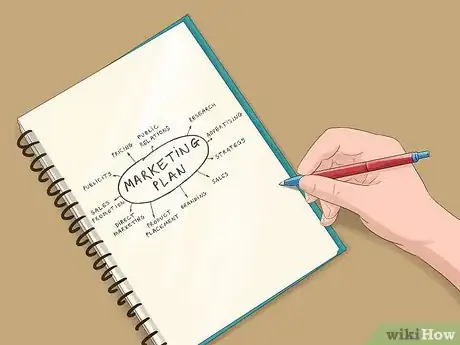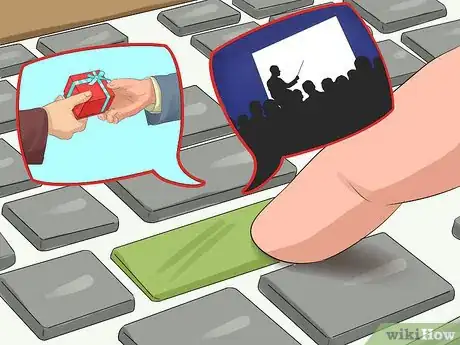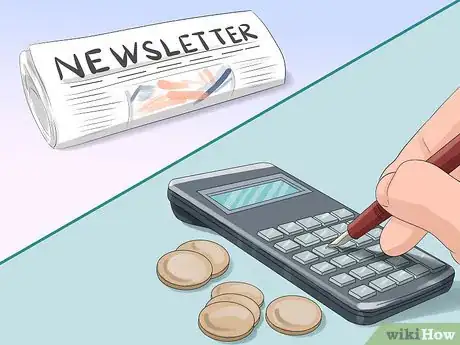This article was co-authored by Christine Michel Carter. Christine Michel Carter is a Global Marketing Expert, Best-Selling Author, and Strategy Consultant for Minority Woman Marketing, LLC. With over 13 years of experience, Christine specializes in strategic business and marketing consulting services including market analysis, organizational alignment, portfolio review, cultural accuracy, and brand and marketing review. She is also a speaker on millennial moms and black consumers. Christine holds a BS in Business Administration and Art History from Stevenson University. She is a leader in multicultural marketing strategy and has written over 100 articles views for several publications, including TIME and Forbes Women. Christine has worked with Fortune 500 clients such as Google, Walmart, and McDonald’s. She has been featured in The New York Times, BBC News, NBC, ABC, Fox, The Washington Post, Business Insider, and Today.
There are 7 references cited in this article, which can be found at the bottom of the page.
wikiHow marks an article as reader-approved once it receives enough positive feedback. In this case, 98% of readers who voted found the article helpful, earning it our reader-approved status.
This article has been viewed 130,967 times.
Your marketing strategy should start with a customer problem. A successful product or service solves a problem for the customer. Perform market research to find out what your potential customers want. Use that research to determine how to position the product to meet their needs. Then, you can create a marketing strategy to attract your audience to this product. With this strategy, you want to create brand awareness, generate new leads and ultimately sell your product or service.
Steps
Developing A Product Or Service Offering
-
1Define your ideal customer. Think of the people who buy your product most often or those people who have a problem that your product or service can solve. Your ideal customers may be of a certain age, gender, or income level.[1] [2]
- Determining who your ideal customer is will shape all of your marketing efforts for your product. In order to get the most out of your marketing budget, target your ideal customers.
- You can determine the ideal customer through the client data you keep on your product sales. You can also survey your clients or analyze research generated by competitors in your industry or research firms. Take advantage of free consumer data from the Census Bureau and Department of Labor.[3]
- For example, if you sell outdoor technology equipment, your ideal customer might be a male or female between the ages of 25 and 50 years old, as these people are both more active than older people and have more disposable income than younger people.
- In addition, you estimate that your ideal customer lives in the western US, as people there spend more time outdoors than those in other parts of the country, and has an upper level or high level of income, as your outdoor equipment is relatively expensive.
-
2Solve a problem for the customer. Consumers have problems that they want to solve. If you work with clients in a particular industry, use your customer knowledge to find a problem you can address.[4]
- Research a product idea. Many businesses develop great products that relate to other successful products they sell. Think about why customers use your existing products. You may be able to solve another problem that is slightly different.
- Say, for example, that customers tell you that they need a durable cell phone charger that will hold up if dropped or exposed to extreme weather.
- To solve this problem, you create a charger that is weather-proof and shock-proof. Hikers and bikers try your phone charger and like the results.
Advertisement -
3Apply the concepts of marketing to your product and your ideal customer. Once you've identified your ideal customer and solved his problem with your product, you can think about the components of your marketing. Think broadly about what you need to do to market your product.[5]
- You'll need to plan a price for your product. Determining a price depends on customer demand for your product, and competitors in your industry. If you don't face much competition and see high demand for your product, you can charge a higher price. Customers may be very sensitive to the price you place on a product.
- Think about how you will package your product and how the packaging fits in with your brand image. You may, for example, create packaging using the same colors and company logo that you use for all of your other products. This consistent use of your brand image will help clients remember your brand.
- Consider how customers will contact your business, order your product and receive what they order. The entire process needs to work efficiently. You need to have a responsive customer service department that will fix any problems a customer may encounter.
Creating A Marketing Strategy
-
1Be clear about your ultimate goal in marketing. Before you start working on your marketing strategy, consider what you want as an end result. Once you identify the end result, you can develop your plan.
- Your firm's goal may be to increase brand awareness, or simply to increase product sales. You may also want to expand into a new market segment. If you're in the hiking and biking gear market, for example, you may want to expand into mountain climbing gear.
- Any goal you set should be compared to a benchmark for your industry. Assume, for example, that there is a tremendous amount of competition in the hiking and biking gear market. No single firm controls more than 5% of the sales in that market. If your goal is to increase sales, you might set 5% as your end goal. The goal fits the conditions in your marketplace.
- You decide that your goal is to increase brand awareness. When someone realizes that they need a better cell phone charger when they go hiking or biking, you want that prospect to know about your company.
- Once you decide on a goal, you can consider which marketing tactics may be effective. A tactic is a specific task you perform to market your product. Direct email, email campaigns, and cold calling are all marketing tactics.
- For example, you might decide that content marketing is a tactic you will use to build brand awareness. You can carry out this tactic by consistently posting useful blogs and articles to your website.
- Once people know about your brand, you want them to ask for more information about your product. They may click through on an ad they see or visit your website. Those people become new leads for sales.
- You want to maintain contact with your leads until a portion of them become customers. They may receive an email or newsletter from you. Other leads may read blogs and articles about outdoor sports on your website. When they decide to purchase a phone charger, they may buy it from you.
-
2Expand your marketing efforts. To increase your sales, you may need to add some new marketing activities. As you add new ways of marketing your product, your firm's brand awareness will increase.[6]
- Find a way to get your brand and business noticed by people. Use tactics and strategies such as public relations and press releases. With these two methods, you can get more online traffic driving consumers to your website and/or business.
- All companies should have a website, and many firms write and post blog content.[7] To expand your presence in the market, consider hosting a podcast and speaking at events. If your competitors don't use these strategies, you'll have a chance to stand out.
- Implement a formal system to ask clients for referrals. If a customer does give you a referral, reward them in some way. You can offer the referring customer a free gift or a purchase discount. A referral has a high probability of being converted from a prospect to a client.
- To increase your image as an expert, consider providing seminars or webinars to your market. When people need to solve a problem, they seek out experts.
-
3Create a marketing plan and a budget to implement your plan. It's critical that you write a formal marketing plan. In order to make the plan a reality, you need to budget for each of your marketing activities. There are two main components of marketing: website/organic marketing and paid marketing.[8] [9]
- Website/organic marketing: Optimize your website by writing relevant content, fixing errors, using compelling visuals, and avoiding relying on a website template. You should aim for a unique website design to stand out and write relevant content based on what people will organically search to rank higher in Google's index.[10]
- Paid marketing: Consider running paid ads on platforms like Google, Facebook, Instagram, and LinkedIn to reach out to clients who make specific searches.[11]
- Your plan should include the specific audience you are targeting. That audience is based on the traits of your ideal customer. To find out more about marketing plans, see Create a Marketing Plan.
- Your plan should indicate a timeline for each task to be completed. If you send a monthly e-newsletter, for example, your timeline might state that each newsletter must be sent by the 5th day of each month.
- Align your marketing calendar with consumer trends and demands. For instance, if you sell a product that is holiday-related, plan your campaigns to ramp up towards the holidays.[12]
- Assign each marketing task to a particular person. If the task is assigned, you won't lose track of the progress of that task. Each person can update the entire group on the status of their particular task. Maybe your in-house copywriter is responsible for producing the newsletter.
References
- ↑ Imran Alavi. Marketing Expert. Expert Interview. 31 March 2021.
- ↑ http://www.entrepreneur.com/article/75648
- ↑ Christine Michel Carter. Global Marketing Expert. Expert Interview. 30 September 2020.
- ↑ http://www.businessknowhow.com/marketing/solveprob.htm
- ↑ http://www.businessknowhow.com/marketing/marketing-plan.htm
- ↑ http://www.marketingprofs.com/articles/2015/27549/these-five-handy-strategies-will-expand-your-marketing-influence
- ↑ Imran Alavi. Marketing Expert. Expert Interview. 31 March 2021.
- ↑ Imran Alavi. Marketing Expert. Expert Interview. 31 March 2021.
- ↑ http://www.forbes.com/sites/advisor/2013/04/17/creating-a-successful-marketing-strategy/
About This Article
To develop a marketing strategy, start by defining your target audience and ideal customer using your consumer knowledge and product research. Next, determine what your marketing goal is, like expanding brand awareness or increasing sales. Then, decide on the most effective marketing tactics for achieving that goal and create a budget based on the data you've collected. Finally, break your marketing plan down into tasks and assign each marketing task to a particular person! For more tips on identifying your ideal customer, read on!






























































